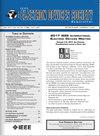Discrete-Trap Effects on 3-D NAND Variability – Part I: Threshold Voltage
IF 2
3区 工程技术
Q3 ENGINEERING, ELECTRICAL & ELECTRONIC
引用次数: 0
Abstract
In this two-part article we discuss the difference between a continuous and a discrete approach to trap modeling in the simulation of 3-D NAND Flash memories with polysilicon channel. In Part I we focus on threshold voltage离散阱对 3-D NAND 变异性的影响 - 第一部分:阈值电压
在这篇文章中,我们将分两部分讨论在多晶硅通道 3-D NAND 闪存的仿真中,陷阱建模的连续方法和离散方法之间的区别。在第一部分中,我们重点讨论了陷阱引起的阈值电压$({\mathrm { V}}_{\mathrm { T}})$波动,并表明当考虑陷阱的离散性时,平均值和均方根值${\mathrm { V}}_{\mathrm { T}}$会更低。我们用离散陷阱情况下更强的渗流导致更低的填充陷阱数量来解释这种差异,并研究了这种差异与电池参数和温度的函数关系。最后,我们对两种方法进行了比较,结果表明连续陷阱模型无法再现离散处理所产生的正确依赖关系。
本文章由计算机程序翻译,如有差异,请以英文原文为准。
求助全文
约1分钟内获得全文
求助全文
来源期刊

IEEE Journal of the Electron Devices Society
Biochemistry, Genetics and Molecular Biology-Biotechnology
CiteScore
5.20
自引率
4.30%
发文量
124
审稿时长
9 weeks
期刊介绍:
The IEEE Journal of the Electron Devices Society (J-EDS) is an open-access, fully electronic scientific journal publishing papers ranging from fundamental to applied research that are scientifically rigorous and relevant to electron devices. The J-EDS publishes original and significant contributions relating to the theory, modelling, design, performance, and reliability of electron and ion integrated circuit devices and interconnects, involving insulators, metals, organic materials, micro-plasmas, semiconductors, quantum-effect structures, vacuum devices, and emerging materials with applications in bioelectronics, biomedical electronics, computation, communications, displays, microelectromechanics, imaging, micro-actuators, nanodevices, optoelectronics, photovoltaics, power IC''s, and micro-sensors. Tutorial and review papers on these subjects are, also, published. And, occasionally special issues with a collection of papers on particular areas in more depth and breadth are, also, published. J-EDS publishes all papers that are judged to be technically valid and original.
 求助内容:
求助内容: 应助结果提醒方式:
应助结果提醒方式:


